Gaps in HIV Testing and Treatment Hinder Efforts to Stop New Infections
New analysis highlights the power of testing and treatment to end the HIV epidemic in the U.S.
The vast majority (about 80 percent) of new HIV infections in the U.S. in 2016 were transmitted from the nearly 40 percent of people with HIV who either did not know they had HIV, or who received a diagnosis but were not receiving HIV care.

Published on the first day of CDC’s 2019 National HIV Prevention Conference, a new CDC Vital Signs report provides the latest data on the impact of undiagnosed and untreated HIV in the nation and underscores the critical need to expand HIV testing and treatment in the U.S.
Getting more people tested and in HIV care is a critical part of the proposed federal initiative, “Ending the HIV Epidemic – A Plan for AmericaExternal.” The initiative’s goal is to end the HIV epidemic over 10 years by focusing first on the geographic areas with the greatest HIV burden, before expanding to reach all areas of the nation affected by HIV.
The proposed initiative is designed to rapidly increase use of these strategies in the 48 counties with the highest HIV burden, as well as in Washington, D.C.; San Juan, Puerto Rico; and seven states with a disproportionate rural HIV burden. The goal is to reduce new HIV infections by at least 90 percent over 10 years.
According to the study findings, about 80 percent of new HIV transmissions are linked to people whose HIV is either undiagnosed or currently untreated. CDC recommends that once a person with HIV learns their status, they begin taking antiretroviral therapy, or ART.
When taken as directed, ART reduces the amount of HIV in the body to a very low level —also known as viral suppression. Studies indicate that people who are virally suppressed can protect their own health and have effectively no risk of transmitting HIV to others through sex, as long as they stay virally suppressed.
The findings of the analysis highlight:
•A need to increase the proportion of people who are aware of their HIV status. The nearly 15 percent of people with HIV whose infections are undiagnosed, account for almost 40 percent of all HIV transmissions.
•It’s critical to help those with HIV get care. The roughly 23 percent of people with HIV whose infections are diagnosed, but they are not receiving HIV care, account for 43 percent of all HIV transmissions.
•The importance of helping people with HIV take medicine and maintain viral suppression. The 11 percent of people with HIV who were receiving care, but were not virally suppressed, account for 20 percent of all HIV transmissions.
Source: U.S. Centers for Disease Control and Prevention
- 288 reads
Human Rights
Fostering a More Humane World: The 28th Eurasian Economic Summi

Conscience, Hope, and Action: Keys to Global Peace and Sustainability

Ringing FOWPAL’s Peace Bell for the World:Nobel Peace Prize Laureates’ Visions and Actions

Protecting the World’s Cultural Diversity for a Sustainable Future

Puppet Show I International Friendship Day 2020

